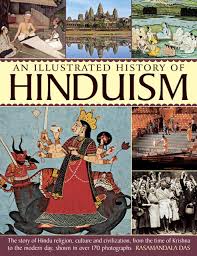HISTORY AND STORY OF HINDUISM
.jpg)
HISTORY AND STORY OF HINDUISM
The lords of the AryansVishnu, Shiva and Brahma Hinduism in southeast Asia
The lords of the Aryans: from 1500 BC
The primary traceable foundations of Hinduism lie with the attacking Aryans, who move into the northwest of the Indian subcontinent from around 1500 BC (see the historical backdrop of India for late archeological contentions against the idea of an Aryan intrusion). The Aryans' religious position, the Brahmans, are in charge of the conciliatory ceremonies (the most grave, among this traveling individuals, being the forfeit of a stallion). The custom songs which they serenade, go down orally for a long time, are assembled in the Rigveda, the most punctual of every religious content.
The songs of the Rigveda uncover that the premier divine force of the Aryans is Indra, a war god and an awesome slayer of devils and creatures. He is perhaps in light of a chronicled pioneer of the Aryans in their progress into India, for one of his titles is 'city-breaker'.
The two other primary divine forces of the Aryans are Agni, the lord of flame; and Soma, a divine being related with a drink (additionally called soma and most likely stimulating) which has a noteworthy impact in the clerics' ceremonies. In the long haul none of these divine beings highlight conspicuously in Hinduism. In any case, two minor characters are sitting tight in the wings for a noteworthy part.
Vishnu shows up in the Rigveda as a sun god who at times encourages Indra to kill evil presences. Furthermore, Shiva (under the name of Rudra) has a little and evil part, sneaking in the mountains, shooting people and creatures with his bolts, and both causing and curing sickness.
Vishnu, Shiva and Brahma: from 300 BC
By around 300 BC, when Indian myth and society story start to combine in the Mahabharata, Vishnu and Shiva are rising as the principle Hindu divine beings. In many ways they are immediate contrary energies of each other. Vishnu is related with creation, Shiva with demolition - however in the everlasting cycle of occasions pulverization must go before the following demonstration of creation, so there isn't the unmistakable good contrast between the divine beings that the words would regularly suggest.
In any case, contrary energies do require a center way, a compromise. This is given by another god, Brahma, who by the first century BC develops as the focal and senior figure in the Hindu trinity. He along these lines procures the part of maker (Vishnu turning into the preserver, and Shiva remaining the destroyer). Brahma's name plainly identifies with the Brahman, the minister. It is thought maybe to have been a catchphrase in conciliatory chants.
Brahma has had no famous religion in India, for he is it could be said the godhead behind the various divine beings. Be that as it may, Vishnu and Shiva turn out to be convincingly settled as the two primary divinities of well known Hinduism. The greater part of sanctuaries in India today are hallowed to either.
Sanctuaries to Vishnu are frequently not straightforwardly connected with his name, for he is accepted to have had a wide range of incarnations and he is generally revered as one of these. By a wide margin the most well known of these incarnations, or symbols, are Krishna (related with the compelling Bhagavad Gita) and Rama.
By differentiate, sanctuaries to Shiva take a standard and effectively conspicuous frame. At the passageway there is constantly the leaning back figure of Nandi, the consecrated bull who conveys Shiva on any excursion.
Raised on a stage, Nandi looks into the focal place of worship of the sanctuary where the ruler Shiva is spoken to in representative shape as an adjusted stump of stone - the linga, or phallus - to which ministers and explorers make offerings of blooms, foods grown from the ground.
The vivid polytheism of well known Hinduism is the sparkle on the surface of a confidence which is basically austere. Likewise with alternate religions beginning in India (Jainism, Buddhism, Sikhism), a definitive reason for any sincere Hindu is to escape from the repeating example of presence.
The count of a man's life is his or her karma (activity). This is the aggregate of the acts of kindness or sacrosanct practices which have been completed. In the transient a decent karma will prompt resurrection in luckier conditions, or in a higher position. Inevitably it might make conceivable the perfect, which is moksha ('discharge' from this world and from the cycle of resurrection).
Hinduism in southeast Asia: from the first century Advertisement
Merchants from India, progressively audacious as seafarers from the first century Advertisement, bring Hinduism through southeast Asia. On the territory (Burma, Cambodia, the southern piece of Vietnam) and in the islands (Sumatra, Java), Hindu kingdoms are built up. In later hundreds of years amazing Hindu sanctuaries are constructed. Angkor Wat is just the best known.
As in India itself, Hinduism and Buddhism exist together in the early hundreds of years. In southeast Asia, Buddhism in the long run wins and Hinduism blurs away (aside from in the little island of Bali). In India, by differentiate, Buddhism vanishes in its country - leaving the field to the subcontinent's first incredible religion, Hinduism, and to a newcomer, Islam.
U like my post so please upvote 4 upvote
Nice post
Thanks
Good
Hmmmm
Vuuu
Hmm
☺
Congratulations @kstalks! You have completed some achievement on Steemit and have been rewarded with new badge(s) :
Click on any badge to view your own Board of Honor on SteemitBoard.
For more information about SteemitBoard, click here
If you no longer want to receive notifications, reply to this comment with the word
STOPThanks